Your cart is currently empty!
Blog
-
Silver Fish Forks vs. Silver-Plated: What’s the Real Difference?
Silver Fish Forks vs. Silver-Plated: What’s the Real Difference?
🧭 Introduction
If you’re shopping for elegant fish forks, you’ve likely encountered two terms: “sterling silver” and “silver-plated.” While they may look similar at first glance, they’re worlds apart in terms of value, durability, and dining experience. Here’s how to choose the right one for your needs.
💍 Sterling Silver: The Real Deal
Definition:
Sterling silver is an alloy containing 92.5% pure silver, often marked “925” or “Sterling”.✅ Pros:
- Higher value, both functionally and collectible
- Naturally antibacterial and corrosion-resistant
- Ages beautifully with use (develops rich patina)
❌ Cons:
- More expensive
- Requires regular polishing
- Softer metal—can bend if mishandled
🥄 Silver-Plated Fish Forks
Definition:
Made from base metal (like brass or stainless steel) with a thin silver coating applied through electroplating.✅ Pros:
- More affordable
- Easier to find in large sets
- Resistant to minor scratches
❌ Cons:
- Silver coating can wear off over time
- Not ideal for collectors
- Often lacks the “feel” and balance of solid silver
📷 Suggested image: Side-by-side comparison of sterling vs. plated fish fork.
🧪 How to Tell Them Apart
Test Result Magnet Test Sterling is not magnetic; many plated are Hallmark Inspection Look for “925”, “Sterling”, or known makers Acid Test (for experts) Confirms silver purity (not for beginners)
💬 Which Should You Choose?
Choose Sterling Silver if:
- You want an heirloom or investment
- You’re hosting elegant events
- You appreciate fine craftsmanship
Choose Silver-Plated if:
- You’re on a budget
- You need a large set for casual dinners
- You want the look without the care needs
🏁 Conclusion
Both sterling silver and silver-plated fish forks have their place in the dining world. It all depends on your purpose—everyday elegance or timeless treasure. Now that you know the difference, you can invest in the right kind of sparkle for your seafood experience.
Views: 1
-
What are the benefits and disadvantages of sterling silver flatware?
What are the benefits and disadvantages of sterling silver flatware?
Benefits of Sterling Silver Flatware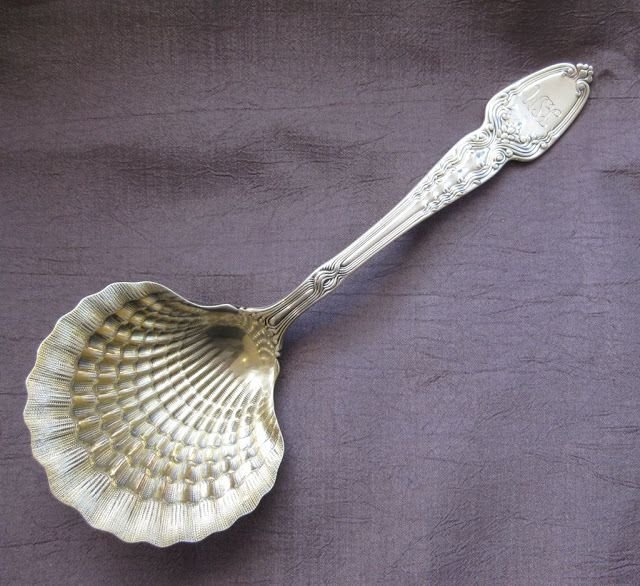
Antibacterial properties
Silver has natural antibacterial properties. Several studies have shown that silver ions are effective in inhibiting the growth of bacteria and reducing the risk of food contamination. Using sterling silver flatware can go some way to ensuring hygienic eating and drinking, especially during family dinners or when hosting guests.
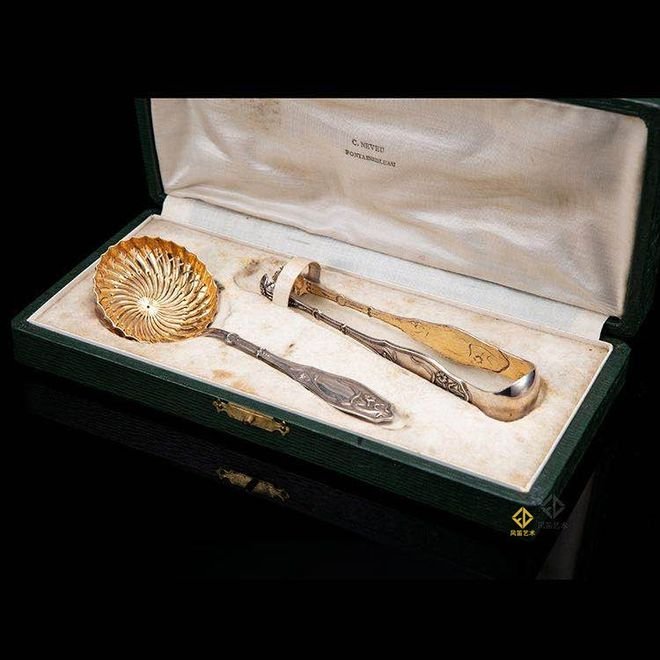
Elegant appearance
The luster and texture of sterling silver flatware makes it look elegant and classy at the dinner table. Whether it’s a family gathering or a formal dinner, silver flatware enhances the entire dining experience and gives it a luxurious feel. Many people consider sterling silver flatware as part of their home décor, showcasing their unique taste.
Durability
Although silver is a relatively soft metal, high-quality sterling silver flatware can last for years without breaking down with proper care. Compared to ceramic and glass flatware, silver flatware is less prone to breakage when in use, making it suitable for home use.
Good thermal conductivity
Silver has excellent thermal conductivity, which means that food can be kept warmer with silverware. Whether it’s a hot soup or a cold drink, silver flatware goes some way to helping maintain the ideal temperature of your food so you can enjoy it better.
Sterling silver has a certain value in the market, and silver flatware can be seen as an investment, especially if the price of precious metals is on the rise. Even after many years, the value of sterling silver flatware tends not to depreciate significantly, but may instead increase in value due to its history and craftsmanship.
The Downside of Sterling Silver Flatware
Sterling silver flatware costs more to make and is usually more expensive to purchase. This can be a significant financial burden for many families. The cost of caring for and maintaining silver flatware also needs to be considered.
Regular maintenance is required
Silver flatware is prone to oxidation and can become dull or darkened after a long period of non-use. This requires regular cleaning and polishing to maintain its shine and appearance. For busy families, regular maintenance may seem cumbersome.
May cause allergic reactions
Although sterling silver itself does not usually cause allergic reactions, some people may develop allergies to other metals in the silver alloy, such as nickel. When choosing silver flatware, it’s important to know what’s in it, especially for those with sensitive skin.
Unsuitable for certain foods
Certain acidic foods (e.g. lemon, vinegar, etc.) reacting with silver may cause discoloration of the flatware or produce a bad taste. When using silver flatware, you need to be careful with your food choices so as not to detract from the dining experience.
Heavier weight
Sterling silver flatware tends to be heavier compared to other materials. This may cause some inconvenience when using it, especially for children and the elderly, who may be less comfortable using heavy flatware.
How to choose and care for sterling silver flatware?
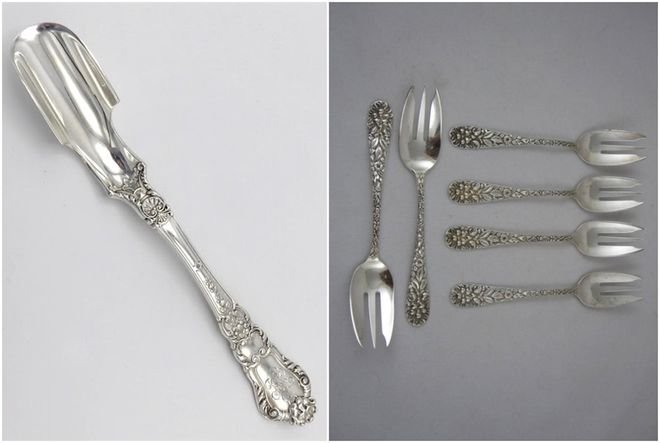
Choosing high-quality silver flatware
When purchasing sterling silver flatware, choose reputable brands and merchants to ensure the purity of the material and fine craftsmanship. Check the product label to confirm that the purity of the silver should generally be above 92.5% (i.e. 925 silver).
Regular Cleaning and Maintenance
After use, silver tableware should be cleaned promptly with warm water and mild detergent, avoiding detergents containing chlorine or acidic ingredients. After cleaning, try to dry with a soft cloth to prevent the formation of water marks. Regular polishing with silver polish can effectively slow down the oxidization process.
Reasonable storage
When not in use, silver tableware should be stored in a dry place, preferably in a special bag that prevents oxidation and reduces contact with the air. Avoid contacting silver tableware with other metals to avoid mutual chemical reactions.
As mentioned earlier, try to avoid using silver tableware to serve acidic food or prolonged exposure to salt. Try to avoid putting silver flatware in the dishwasher or microwave, which may damage its surface or affect its texture.
Sterling silver flatware has both its unique advantages and certain drawbacks. When considering a purchase, you need to make a choice based on your needs, budget, and dining habits. Whether you choose to use sterling silver flatware or another material, the most important thing is to make every meal delicious and enjoyable. Hopefully, this game guide will help you better understand the benefits and drawbacks of sterling silver flatware and make an informed decision.
Views: 3
-
How to Identify Authentic Antique Silver Fish Forks?
How to Identify Authentic Antique Silver Fish Forks?
🧭 Introduction
Antique silver fish forks are more than beautiful—they’re part of culinary history. But how can you tell a genuine vintage piece from a reproduction? In this guide, we’ll walk you through the key signs of authenticity, markings, materials, and how to appraise their value.
🕰️ What Makes a Fish Fork Antique?
By most standards, any item over 100 years old qualifies as antique. Many silver fish forks from the 19th and early 20th centuries are highly collectible today.

🔎 Look for These Authenticity Markers
1. Hallmarks and Stamps
Silverware typically has hallmark symbols indicating:
- Purity (e.g., “925” or “Sterling”)
- Maker’s mark (like Gorham’s anchor or Tiffany’s “T&Co”)
- Date letter or country symbol (lion passant = English sterling)
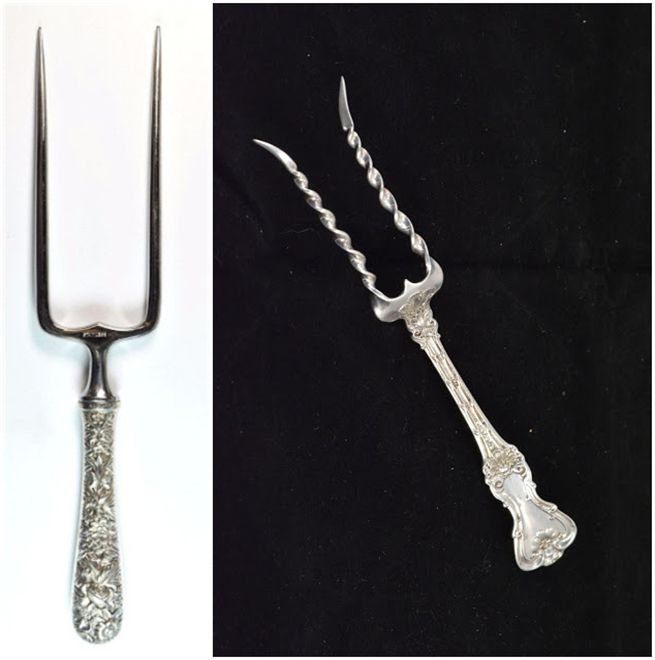
2. Signs of Handcrafting
- Irregularities in engraving or detailing
- Visible tool marks under magnification
- Heavier weight than modern reproductions
3. Style and Pattern
Popular antique styles include:
- Victorian floral motifs
- Art Nouveau curves
- Art Deco geometrics
Use pattern guides from companies like Wallace or Reed & Barton to identify the era.
📦 Where to Find Authentic Silver Fish Forks
- Estate sales and auctions
- Reputable antique dealers
- Online vintage marketplaces (e.g., 1stDibs, Ruby Lane)
- Specialist stores like FishForks.com with verified provenance
💰 Understanding Value
Factor Impact on Value Maker and rarity Christofle or Tiffany often command higher prices Purity of silver Sterling (92.5%) is more valuable than silver-plated Condition Tarnish is okay, but deep scratches or bent tines reduce worth Completeness Full sets or matched forks and knives fetch a premium
🛡️ Tips for Collectors
- Keep documentation (receipts, maker info)
- Store in a dry, tarnish-resistant case
- Never polish off hallmarks—these prove authenticity
🏁 Conclusion
Antique silver fish forks are not only gorgeous—they’re historical treasures. With a bit of knowledge and a careful eye, you can build a collection that’s as valuable as it is beautiful.
Views: 4
-
How exactly did the oddly shaped British Victorian cutlery work?
How exactly did the oddly shaped British Victorian cutlery work?
Do a search for “silverware” and you’re sure to see a lot of strange objects – berry spoons, strawberry spatulas, harpoons …… – that seem to get the point, but how do you use them?
Why did people invent these many strange and weird tableware? Editor Sherlock Holmes on the body, finally found most of the answers in the Victorian period ……
Victorian what and what and what needs to be what and what and what?
When it comes to the tableware on the head of the thought of the place, the Victorian period (1837 ~ 1901) dare to call the five thousand years of the second “work”, I am afraid there is not too much objection to compete for the first.
That was the time when the “English table manners”, which were highly praised by later generations, were gradually taking shape, and the types and quantities of cutlery came along with it, sometimes using dozens or even hundreds of cutlery for a banquet.
However, after more than a hundred years, some of these dishes have lost their “context” and become more and more “unbelievable” ……
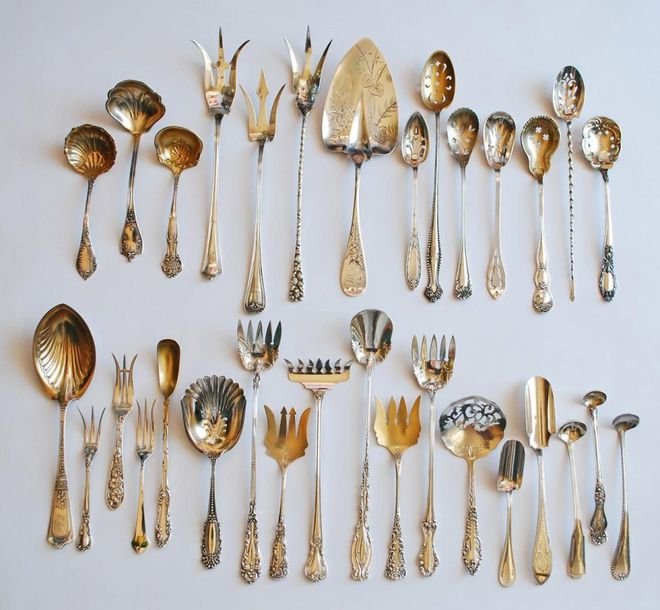
Pic: What is this and what is this? 丨Picture from the Internet
Harpoon – more occasions more choices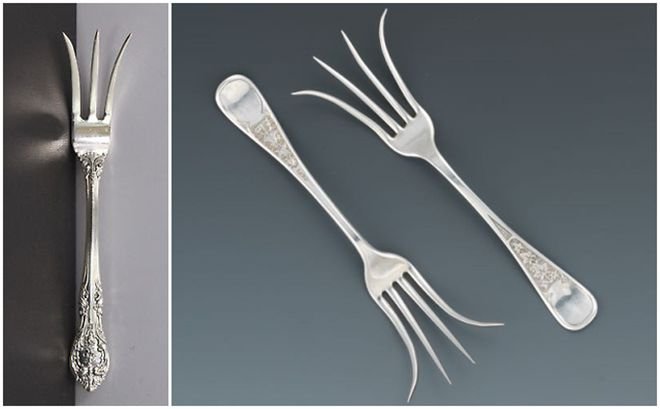
Picture: Lemon fish Fork, Lemon Fork (left)Lettuce ForkLettuce Fork (right)丨Picture from the network
They look pretty much the same, don’t they? But there’s a big difference: the lemon fork’s open tines are designed to pierce lemon zest, and are said to be commonly used when drinking tea (you’ve heard of the Brits’ love of tea, huh?); while the lettuce fork is larger and can be used to pierce those tough lettuce leaves. ); while the lettuce fork is larger and can be used to pierce those tough lettuce leaves.
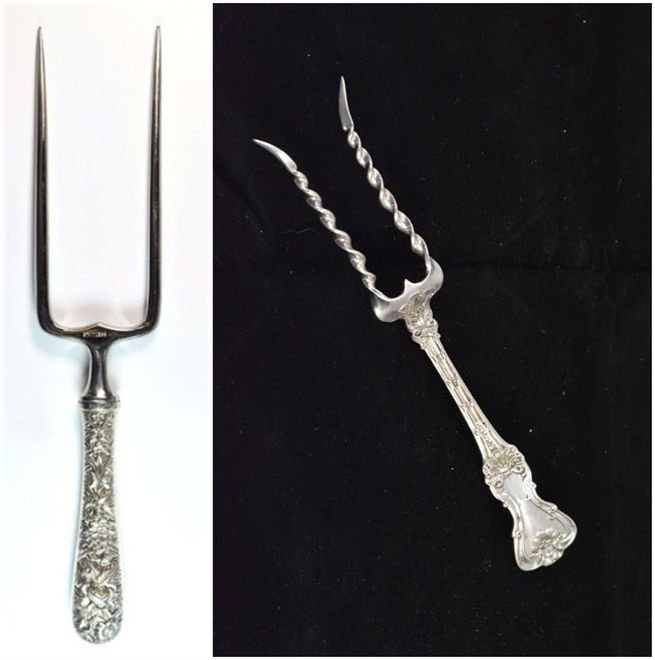
Figure: Joint Fork (left) Potato Fork (right) 丨 ⧏35⧐ figure from the web ⧏34⧐
Some harpoons serve primarily as immobilizers.
How can a lady or a gentleman stand the embarrassment of meat sliding around on the plate when a joint fork, for example, is used to hold the meat in place while slicing? The swirling tines on the potato fork make potatoes less likely to fall off, thus avoiding a bad moment at the table (ohh……).
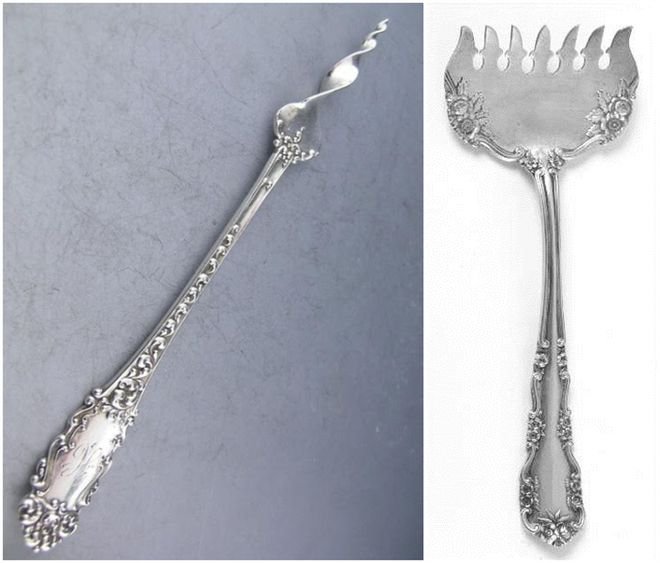
Picture: Butter Pick (left) Canned Fish/Sardine Fork Sardine Fork (right) 丨Picture from the Internet
Some harpoons are designed for easy access to food. Stylized rotary butter picks can take butter kept in a bucket or jar, wring it out smoothly, and then style it on the fly: it’s said that wrung butter looks like beautiful curls, and it’s pretty to think about when you put it on ice; the same goes for sardine forks, which allow one to more elegantly take greasy fish out of the can ……
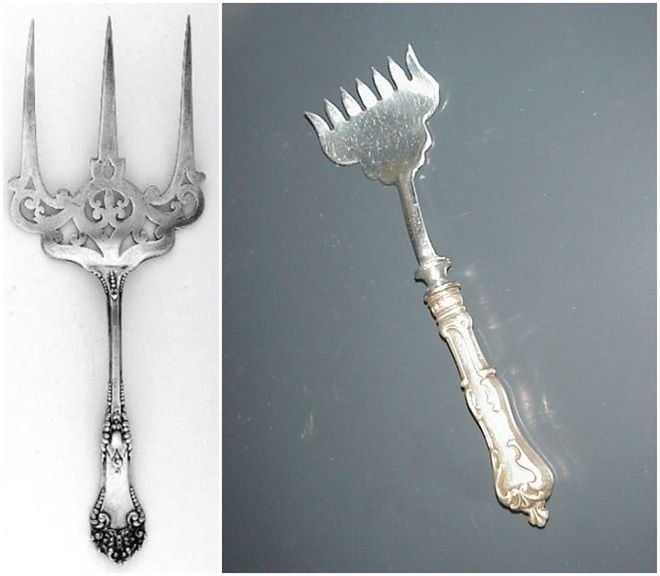
Picture: Toast Fork (left) Bacon Fork (right) 丨Picture from the network
If those introduced earlier are still somewhat practical, some of the “work” is a bit inexplicable – the left picture of the fork out of a piece of toast bread (and the difference between the ordinary fork really do not see), and the right picture and the sardine fork basically looks no different, but it is a bacon fork. But it is a bacon fork ……
Spoon – More Ingredients More StageHow can a single harpoon with different functions be enough, too “simple and crude”, the sophisticated Victorianers tell you – the spoon must also have a pattern!
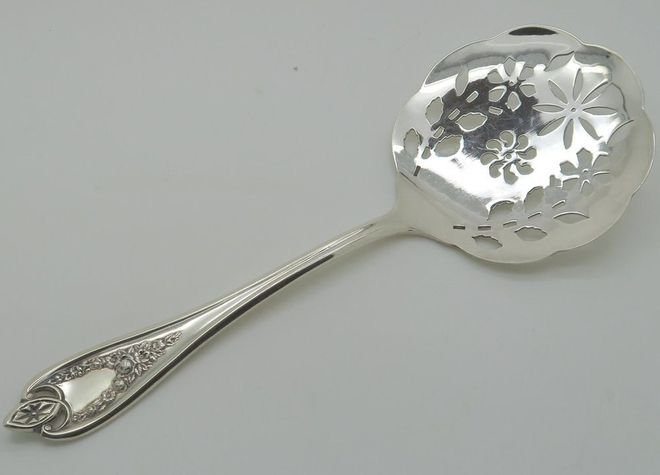
Picture: Thinly Sliced Tomato Spoon Tomato Server丨Picture from the Internet
Specializing in scooping thinly sliced tomatoes, the hollowed out pattern allows excess juice to escape, oh wow, I have to bow my poor head in admiration ……
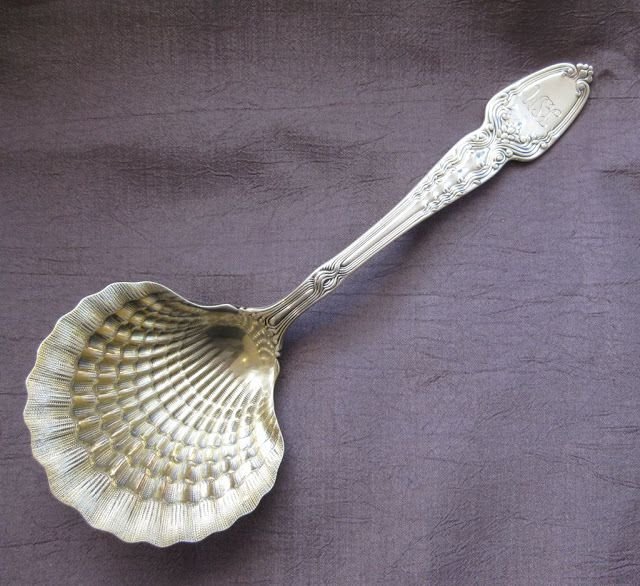
Picture:Berry Spoon丨Picture from the Internet
This spoon specializing in scooping blueberries and other small fruits, of course, usually the value of the spoon itself must be high, exquisite pattern must be arranged; because small fruits do not have juice leakage, so do not worry about not good to wash …… However, adhering to the “one kind of fruit needs to be matched with a kind of tableware However, adhering to the “a fruit needs to be accompanied by a kind of tableware,” the rigorous spirit of the Victoria er, strawberries must also have their own “small followers” —
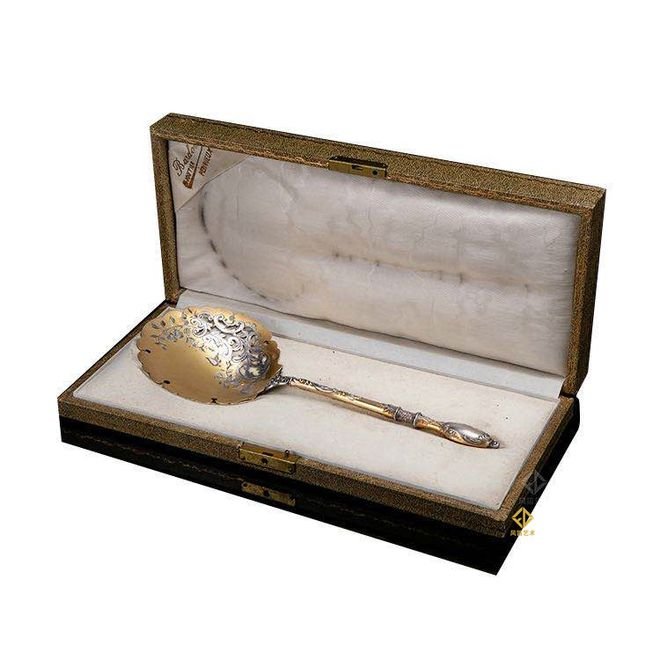
Product Image: 19th Century Strawberry Spade丨Picture from bagpipe art e-commerce platform
There are some scoops that specialize in hard things, such as the fluent alignment on the sides of the cheese scoop that facilitates scooping cheese out of hard cheeses, and the jagged shape of the ice cream scoop that makes digging into frozen custard easier.
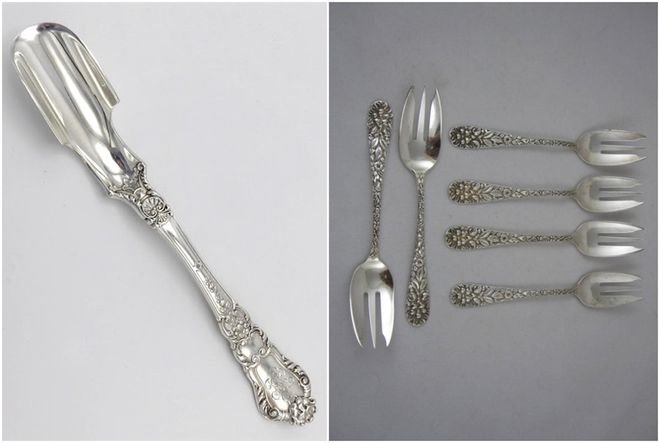
Picture: Cheese Scoop (left) Ice Cream Forks (right) 丨Picture from the Internet
By the way, before the ice cream scoop was invented in 1897, people used an Ice Cream Slicer to make “ice cream” (pre-1897 ice cream mentality).
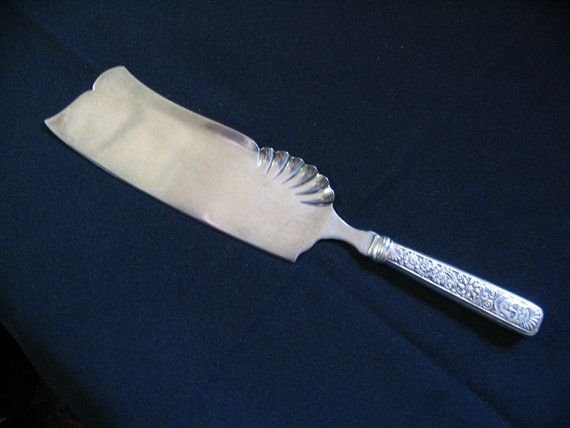
Ice Cream Slicer丨Picture from the web
There are spoons that can be used exclusively by the British. In their day, people mixed gelatin with meat, poultry, fish, eggs, and other ingredients to make jellies, allowing the gelatin to stop the food from coming into contact with air. The spoon for eating this jiggly, rah-rah stuff would have to look like a knife and a spoon, be able to cut and bear, and by the way, it would be ……real convenient to poke and dig for solid food ……real in the meat jelly with the tip of the spoon. By the way, sterling silver cutlery is also said to protect against a bacteria or something – technology is not developed, use cutlery to make up for it (how to think of a silver needle to test for poison ……).
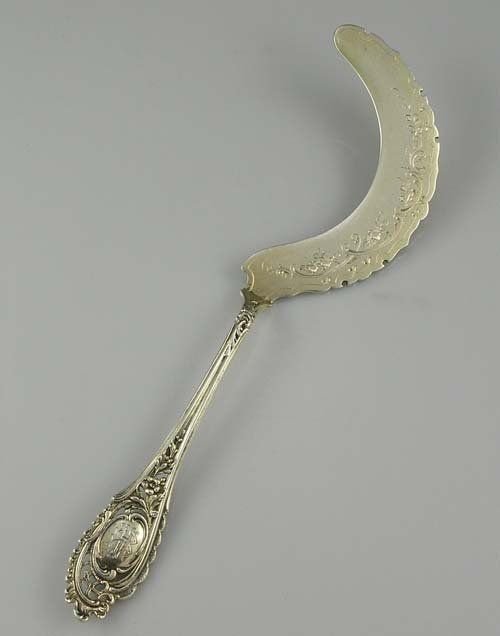
Picture: Meat Jelly Spoon Aspic Spoon丨Picture from the Internet
The unthinkable is here ……

Picture: Cake comb丨Picture from the Internet
Cake needs a “hairbrush” too? After careful research, I found that this is very practical – insert the sharp teeth into the desired cutting position, and then gently rock back and forth to separate the cake, eek, seems to be much more elegant than using a cake knife to poke around!

Picture:Food PusherBaby Food Pusher丨Picture from the Internet
This thing is not for the Second Brother, it is a “food pusher” for children – a pusher and spoon to help them easily push food onto their plates. …… Well, it’s true! It’s a Victorian er, table manners start with children!
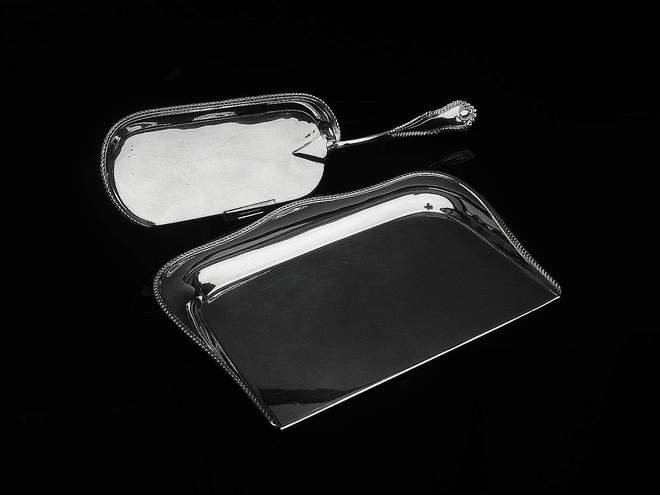
Picture:Crumb Scoop And Tray丨Picture from the Internet
This is a pizza spatula? NONONO, it’s a crumb spatula… In the 1850’s, servants used it to clean up bread crumbs and salad drippings from the dinner table… it seemed more elegant than using a dustpan and broom or a rag… (It’s amazing that servants had to be elegant to clean up the dinner table!)
In fact, these are only the tip of the iceberg of the Victorian silver tableware, there are spoon heaters, grape shears Grape Scissors, Knife Rest, Caddy Spoons Caddy Spoons …… limited to space (too much) really do not have the opportunity to appear. I picked up the chopsticks in my hands, can not help but fall into thought, why do people have to eat their fill of invention of so many cumbersome work on the sky, but it is indeed beautiful and good to see want to buy home to appreciate the tableware?
Do you have a lot of question marks, kids? Let me tell you ……
Actually, specialized yet targeted tools do work well!
In the experience of Kat Kinsman, antique flatware enthusiast and editor-in-chief of CNN’s food blog, her spoon with its wide, deep, curved bottom can be tilted to spread soup every time you have it, and the notch in the spoon filters out excess oil, so don’t be too fabulous for someone who is a stickler for good eating and a lot of demands.
In addition, it is true that there are some tableware that seem to be dispensable nowadays, but were very much in use at particular times in history. For example, sugar holders. During the Victorian period, sugar was a precious commodity, and those who had it would keep it in a locked sugar chest, the key to which could only be held by the hostess. Whenever tea was served or other occasions when sugar was used, the hostess used special little holders to distribute rare sugar cubes to her guests. While sugar cubes are common nowadays, silver sugar clips have become a special style of “elegant hostess afternoon tea” with a strong vintage flavor.
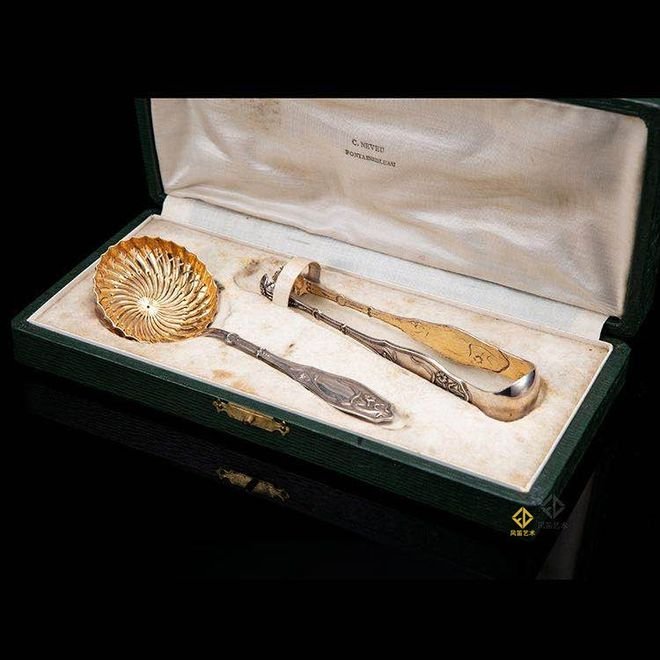
Photo: 19th Century Sugar Sprinkles and Sugar Clips Two-Piece Set 丨Picture from Bagpipe Art e-commerce platform
Moreover, no matter what time and place, the table is the most important social occasions, table utensils on the table all about the table host and the identity and status of the invitees.
Louis XV’s dinner table, there has been a solid gold “treasure ship”, which is loaded with spoons, napkins, salt shakers, test horn ……, Louis XV himself does not use, it has become a kind of ritual. Even if the king is not present, as long as you see the “boat”, men have to take off their hats, women also have to bow.
Not to mention the fancy assorted food boxes, napkins, candlesticks, baskets, and glazed chandeliers …… all serving to show off the king’s majesty.
Britain’s “dining style” was relatively recent, but the technique of elevating tableware to a status symbol was used with ease. In the Victorian era, when the British Empire reigned supreme around the world, this trend naturally became more and more intense.
It is attested that dinner parties of the time often included a minimum of twelve or more courses.
Imagine: each person’s cheese, fish, fruit, steak, chicken steak, lamb stew …… has to be accompanied by a different set of cutlery, each with its own butter knife, salt shaker, salt dish, and seasonal game utensils …… the table indicates, okay?
What’s even more interesting is that this “unspoken rule of ZZ at the table” exists in every culture.
Wine lecturer Qi Shaoren said than a decade ago in France, today’s table can be much more simple, even the traditional French aristocratic families, no longer to tableware to show off their wealth, “instead of the banquet on the main chef’s loud name and all over the air transported over the rare seasonal ingredients.”
Nicolas Defrémont, who has been serving in the hotel world for many years, has switched things up by having his staff replace the appropriate specialized tableware at the right time, depending on what the guest has ordered (tableware-choice-phobes can breathe a sigh of relief). After all, more than the so-called dining etiquette, attentive service is the core competence of the restaurant.
And Arthu rInchInch, a consultant on the movie Gosford Hall, said, “Such over-the-top Victorian table furnishings, from chocolates spoons for drinking to eight different styles of special forks for broccoli, are a phenomenon of the middle class only.” — Rumored to be rarely used by royalty, a question mark that I can’t answer ……
The bagpipes say
I’m sure you’ll say, isn’t the cutlery for the food? It’s the good food that counts, right?
Putting aside the element of social bragging, perhaps we can understand that in a particular context, abundant ingredients = enough spending power; exquisite tableware for each ingredient = both taste and sophistication; and a full complement of tableware for each guest = recognition and respect.
By the way, these complicated tableware sometimes have unexpected effects – according to legend, the French Bishop Richelieu once at the banquet table to reveal the true face of a liar, because he ate olives with a dinner fork, a farcical half will not use complicated tableware there is such an effect … … …
Some information collated from the Internet
Part of the picture from the network, infringement and deletion
Written by: Read | Edited by: Fuguer
Bagpipe Introduction:
Do a search for “silverware” and you’re sure to see a lot of strange objects – berry spoons, strawberry spatulas, harpoons …… – that seem to get the point, but how do you use them?
Why did people invent these many strange and weird tableware? Editor Sherlock Holmes on the body, finally found most of the answers in the Victorian period ……
Victorian what and what and what needs to be what and what and what?
When it comes to the tableware on the head of the thought of the place, the Victorian period (1837 ~ 1901) dare to call the five thousand years of the second “work”, I am afraid there is not too much objection to compete for the first.
That was the time when the “English table manners”, which were highly praised by later generations, were gradually taking shape, and the types and quantities of cutlery came along with it, sometimes using dozens or even hundreds of cutlery for a banquet.
However, after more than a hundred years, some of these dishes have lost their “context” and become more and more “unbelievable” ……
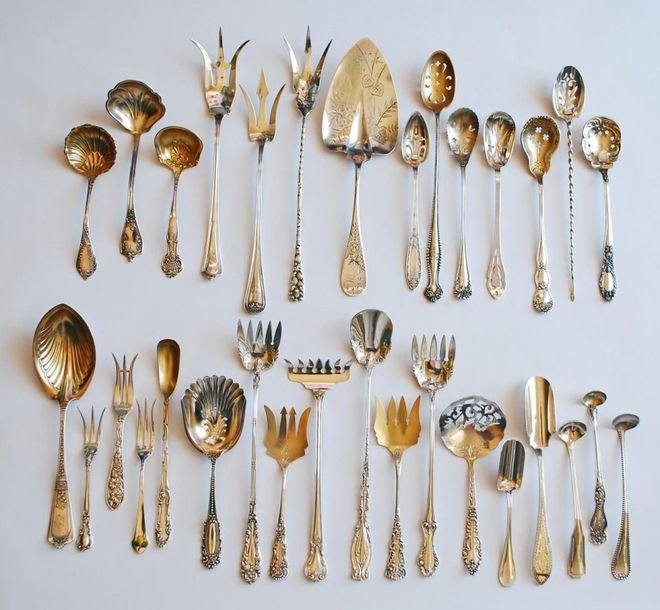
Pic: What is this and what is this? 丨Picture from the Internet
Forks – more occasions more choices
Picture: Lemon ForkLemon Fork (left)Lettuce ForkLettuce Fork (right)丨Picture from the network
They look pretty much the same, don’t they? But there’s a big difference: the lemon fork’s open tines are designed to pierce lemon zest, and are said to be commonly used when drinking tea (you’ve heard of the Brits’ love of tea, huh?); while the lettuce fork is larger and can be used to pierce those tough lettuce leaves. ); while the lettuce fork is larger and can be used to pierce those tough lettuce leaves.
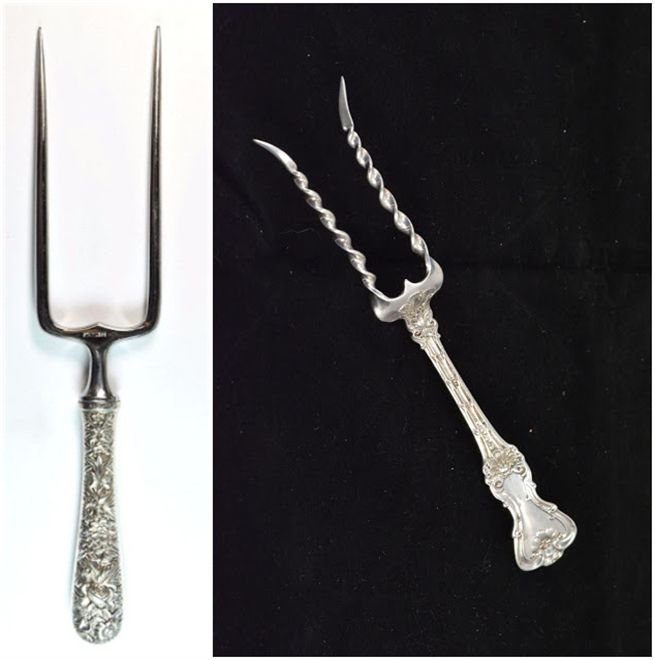
Figure: Joint Fork (left) Potato Fork (right) 丨 ⧏35⧐ figure from the web ⧏34⧐
Some harpoons serve primarily as immobilizers.
How can a lady or a gentleman stand the embarrassment of meat sliding around on the plate when a joint fork, for example, is used to hold the meat in place while slicing? The swirling tines on the potato fork make potatoes less likely to fall off, thus avoiding a bad moment at the table (ohh……).
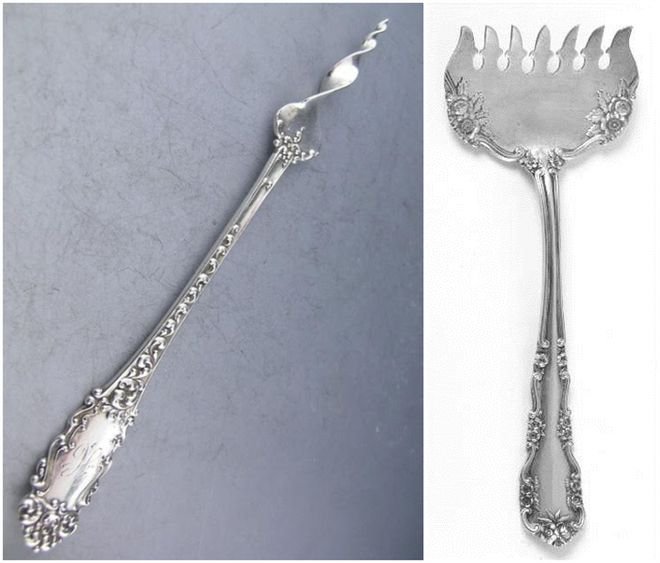
Picture: Butter Pick (left) Canned Fish/Sardine Fork Sardine Fork (right) 丨Picture from the Internet
Some harpoons are designed for easy access to food. Stylized rotary butter picks can take butter kept in a bucket or jar, wring it out smoothly, and then style it on the fly: it’s said that wrung butter looks like beautiful curls, and it’s pretty to think about when you put it on ice; the same goes for sardine forks, which allow one to more elegantly take greasy fish out of the can ……

Picture: Toast Fork (left) Bacon Fork (right) 丨Picture from the network
If those introduced earlier are still somewhat practical, some of the “work” is a bit inexplicable – the left picture of the fork out of a piece of toast bread (and the difference between the ordinary fork really do not see), and the right picture and the sardine fork basically looks no different, but it is a bacon fork. But it is a bacon fork ……
Spoon – More Ingredients More StageHow can a single harpoon with different functions be enough, too “simple and crude”, the sophisticated Victorianers tell you – the spoon must also have a pattern!
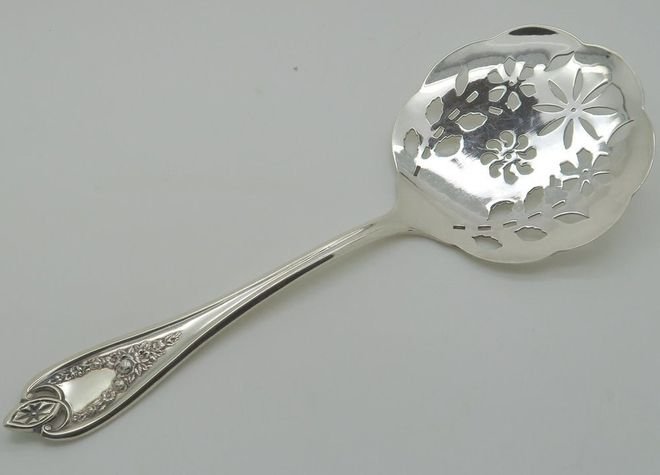
Picture: Thinly Sliced Tomato Spoon Tomato Server丨Picture from the Internet
Specializing in scooping thinly sliced tomatoes, the hollowed out pattern allows excess juice to escape, oh wow, I have to bow my poor head in admiration ……
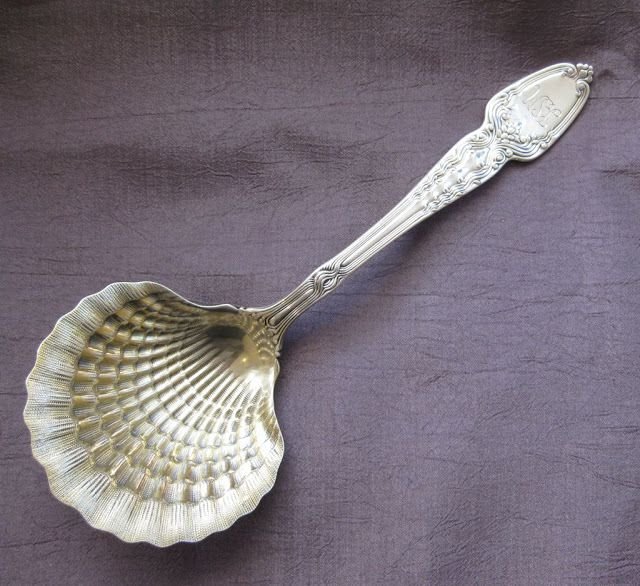
Picture:Berry Spoon丨Picture from the Internet
This spoon specializing in scooping blueberries and other small fruits, of course, usually the value of the spoon itself must be high, exquisite pattern must be arranged; because small fruits do not have juice leakage, so do not worry about not good to wash …… However, adhering to the “one kind of fruit needs to be matched with a kind of tableware However, adhering to the “a fruit needs to be accompanied by a kind of tableware,” the rigorous spirit of the Victoria er, strawberries must also have their own “small followers” —

Product Image: 19th Century Strawberry Spade丨Picture from bagpipe art e-commerce platform
There are some scoops that specialize in hard things, such as the fluent alignment on the sides of the cheese scoop that facilitates scooping cheese out of hard cheeses, and the jagged shape of the ice cream scoop that makes digging into frozen custard easier.

Picture: Cheese Scoop (left) Ice Cream Forks (right) 丨Picture from the Internet
By the way, before the ice cream scoop was invented in 1897, people used an Ice Cream Slicer to make “ice cream” (pre-1897 ice cream mentality).

Ice Cream Slicer丨Picture from the web
There are spoons that can be used exclusively by the British. In their day, people mixed gelatin with meat, poultry, fish, eggs, and other ingredients to make jellies, allowing the gelatin to stop the food from coming into contact with air. The spoon for eating this jiggly, rah-rah stuff would have to look like a knife and a spoon, be able to cut and bear, and by the way, it would be ……real convenient to poke and dig for solid food ……real in the meat jelly with the tip of the spoon. By the way, sterling silver cutlery is also said to protect against a bacteria or something – technology is not developed, use cutlery to make up for it (how to think of a silver needle to test for poison ……).
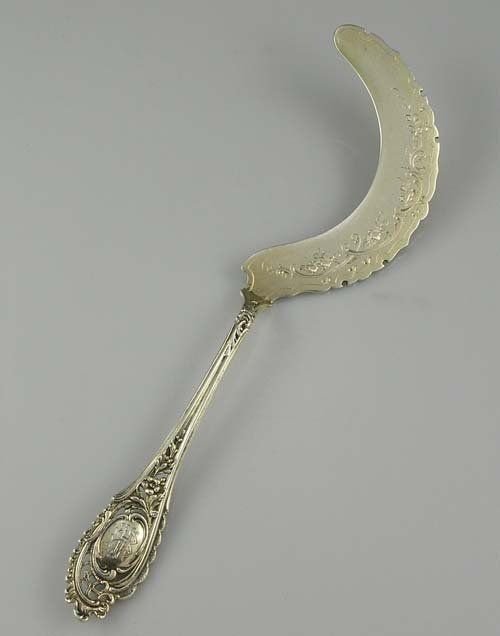
Picture: Meat Jelly Spoon Aspic Spoon丨Picture from the Internet
The unthinkable is here ……
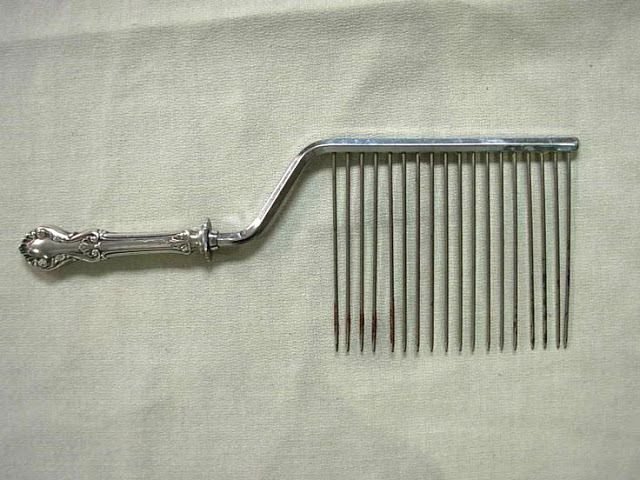
Picture: Cake comb丨Picture from the Internet
Cake needs a “hairbrush” too? After careful research, I found that this is very practical – insert the sharp teeth into the desired cutting position, and then gently rock back and forth to separate the cake, eek, seems to be much more elegant than using a cake knife to poke around!
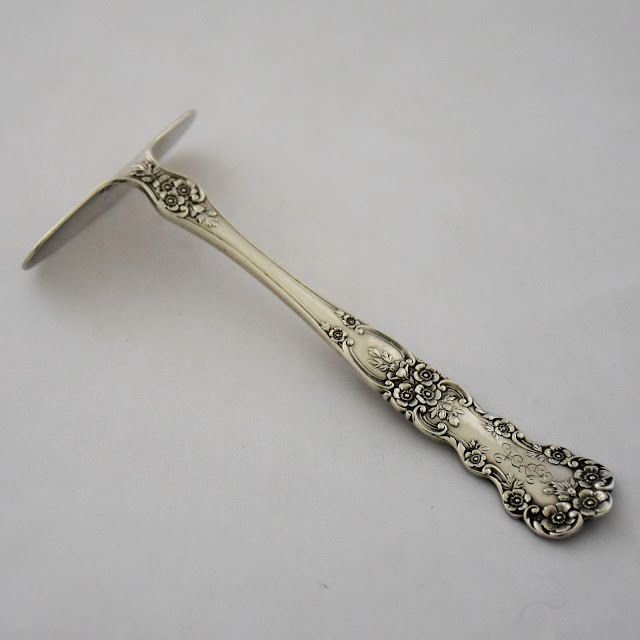
Picture:Food PusherBaby Food Pusher丨Picture from the Internet
This thing is not for the Second Brother, it is a “food pusher” for children – a pusher and spoon to help them easily push food onto their plates. …… Well, it’s true! It’s a Victorian er, table manners start with children!

Picture:Crumb Scoop And Tray丨Picture from the Internet
This is a pizza spatula? NONONO, it’s a crumb spatula… In the 1850’s, servants used it to clean up bread crumbs and salad drippings from the dinner table… it seemed more elegant than using a dustpan and broom or a rag… (It’s amazing that servants had to be elegant to clean up the dinner table!)
In fact, these are only the tip of the iceberg of the Victorian silver tableware, there are spoon heaters, grape shears Grape Scissors, Knife Rest, Caddy Spoons Caddy Spoons …… limited to space (too much) really do not have the opportunity to appear. I picked up the chopsticks in my hands, can not help but fall into thought, why do people have to eat their fill of invention of so many cumbersome work on the sky, but it is indeed beautiful and good to see want to buy home to appreciate the tableware?
Do you have a lot of question marks, kids? Let me tell you ……
Actually, specialized yet targeted tools do work well!
In the experience of Kat Kinsman, antique flatware enthusiast and editor-in-chief of CNN’s food blog, her spoon with its wide, deep, curved bottom can be tilted to spread soup every time you have it, and the notch in the spoon filters out excess oil, so don’t be too fabulous for someone who is a stickler for good eating and a lot of demands.
In addition, it is true that there are some tableware that seem to be dispensable nowadays, but were very much in use at particular times in history. For example, sugar holders. During the Victorian period, sugar was a precious commodity, and those who had it would keep it in a locked sugar chest, the key to which could only be held by the hostess. Whenever tea was served or other occasions when sugar was used, the hostess used special little holders to distribute rare sugar cubes to her guests. While sugar cubes are common nowadays, silver sugar clips have become a special style of “elegant hostess afternoon tea” with a strong vintage flavor.
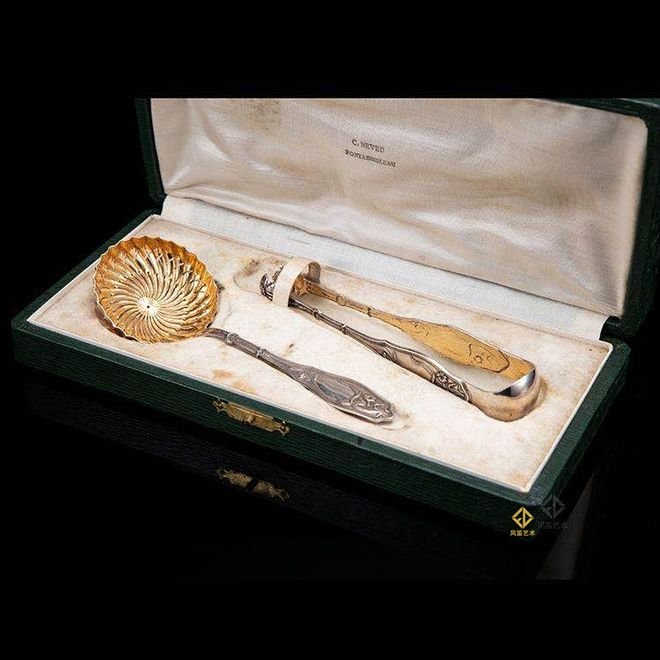
Photo: 19th Century Sugar Sprinkles and Sugar Clips Two-Piece Set 丨Picture from Bagpipe Art e-commerce platform
Moreover, no matter what time and place, the table is the most important social occasions, table utensils on the table all about the table host and the identity and status of the invitees.
Louis XV’s dinner table, there has been a solid gold “treasure ship”, which is loaded with spoons, napkins, salt shakers, test horn ……, Louis XV himself does not use, it has become a kind of ritual. Even if the king is not present, as long as you see the “boat”, men have to take off their hats, women also have to bow.
Not to mention the fancy assorted food boxes, napkins, candlesticks, baskets, and glazed chandeliers …… all serving to show off the king’s majesty.
Britain’s “dining style” was relatively recent, but the technique of elevating tableware to a status symbol was used with ease. In the Victorian era, when the British Empire reigned supreme around the world, this trend naturally became more and more intense.
It is attested that dinner parties of the time often included a minimum of twelve or more courses.
Imagine: each person’s cheese, fish, fruit, steak, chicken steak, lamb stew …… has to be accompanied by a different set of cutlery, each with its own butter knife, salt shaker, salt dish, and seasonal game utensils …… the table indicates, can it be okay?
What’s even more interesting is that this “unspoken rule of ZZ at the table” exists in every culture.
Wine lecturer Qi Shaoren said than a decade ago in France, today’s table can be much more simple, even the traditional French aristocratic families, no longer to tableware to show off their wealth, “instead of the banquet on the main chef’s loud name and all over the air transported over the rare seasonal ingredients.”
Nicolas Defrémont, who has been serving in the hotel world for many years, has switched things up by having his staff replace the appropriate specialized tableware at the right time, depending on what the guest has ordered (tableware-choice-phobes can breathe a sigh of relief). After all, more than the so-called dining etiquette, attentive service is the core competence of the restaurant.
And Arthu rInchInch, a consultant on the movie Gosford Hall, said, “Such over-the-top Victorian table furnishings, from chocolates spoons for drinking to eight different styles of special forks for broccoli, are a phenomenon of the middle class only.” — Rumored to be rarely used by royalty, a question mark that I can’t answer ……
Conclusion:
I’m sure you’ll say, isn’t the cutlery for the food? It’s the good food that counts, right?
Putting aside the element of social bragging, perhaps we can understand that in a particular context, abundant ingredients = enough spending power; exquisite tableware for each ingredient = both taste and sophistication; and a full complement of tableware for each guest = recognition and respect.
By the way, these complicated tableware sometimes have unexpected effects – according to legend, the French Bishop Richelieu once at the banquet table to reveal the true face of a liar, because he ate olives with a dinner fork, a farcical half will not use complicated tableware there is such an effect … … …
Views: 18
-
Why Silver Fish Forks Are the Crown Jewel of Formal Dining?
Why Silver Fish Forks Are the Crown Jewel of Formal Dining?
🧭 Introduction
When it comes to elegant dining, few pieces are as timeless and refined as the silver fish fork. From Victorian banquets to modern wedding receptions, silver flatware adds a distinct touch of luxury to seafood service. In this article, we explore what makes silver fish forks a staple of high-end dining.
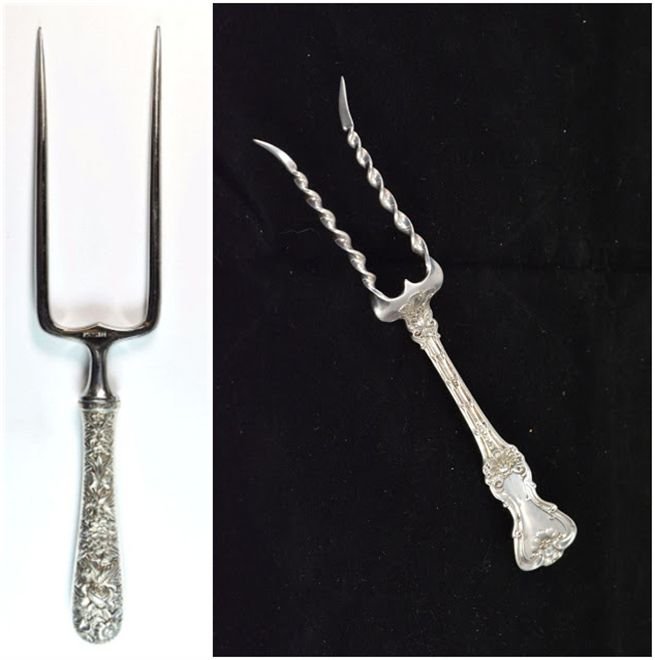
5 advantages of silver fish forks, presented with clarity and accuracy:
- Aesthetic Elegance: Silver fish forks add a luxurious and sophisticated touch to table settings, enhancing the visual appeal of formal dinners and special occasions with their polished, reflective surface.
- Antimicrobial Properties: Silver naturally possesses antimicrobial qualities, which can help reduce bacterial growth, contributing to a more hygienic dining experience.
- Non-Reactive Surface: Unlike some metals, silver does not react with acidic or sulfur-containing foods, ensuring the flavor of delicate dishes like fish remains unaltered by metallic tastes.
- Durability and Longevity: Crafted from sterling silver (an alloy of 92.5% silver and 7.5% strengthening metals), these forks are durable and can become cherished heirlooms when properly maintained, lasting generations.
- Prestige and Tradition: Using silver fish forks aligns with formal dining etiquette, reflecting cultural heritage and attention to detail, while symbolizing refinement and status in social settings.
These advantages combine practicality, tradition, and aesthetic value, making silver fish forks a distinguished choice for discerning hosts.
🕰️ A Brief History of Silver Fish Forks
Silver fish forks first appeared in the mid-1800s, when specialized cutlery became a hallmark of wealth and etiquette. The upper class dined with dozens of utensils—each with a unique purpose. Fish forks were created to serve and eat delicate, flaky fish without shredding it, and sterling silver became the material of choice due to its non-reactive qualities and aesthetic value.
✨ The Functional Elegance of Silver Fish Forks
✅ Why Silver?
Feature Benefit Non-reactive material Preserves fish flavor and avoids metallic aftertaste Natural antibacterial Helps reduce bacteria on utensil surfaces Heirloom quality Lasts generations with proper care Weight and balance Feels substantial and stable in the hand 📏 Design Details
Silver fish forks typically feature:
- Wider, flatter tines for lifting flaky fillets
- Elegant detailing like floral or scrollwork patterns
- Often paired with a matching silver fish knife
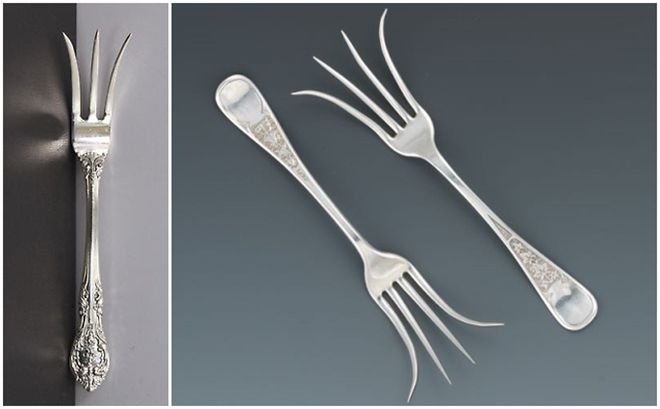
🐟 When to Use a Silver Fish Fork
- Formal dinners with multi-course meals
- Holiday celebrations like Christmas Eve seafood feasts
- Weddings and banquets where elegance is key
- Afternoon teas or vintage-themed gatherings
🛍️ Top Silver Fish Fork Brands
- Christofle – French craftsmanship and luxury design
- Gorham Sterling – Classic American silverware, often collectible
- Towle and Wallace – Intricate patterns and high silver purity
- Georg Jensen – Scandinavian modern meets timeless form
🧼 Care Tips for Longevity
- Hand wash only (no dishwasher)
- Polish regularly with silver-safe polish
- Store in anti-tarnish cloth or wooden chest
- Avoid rubber bands or newspaper when storing (causes tarnish)
🏁 Conclusion
Silver fish forks aren’t just cutlery—they’re heirlooms, expressions of taste, and tools of culinary respect. Whether you’re hosting a formal dinner or looking for a vintage upgrade to your flatware collection, investing in silver fish forks ensures your table always shines.
Views: 17
-
How Fish Forks Elevate the Seafood Dining Experience
How Fish Forks Elevate the Seafood Dining Experience
🎯 Introduction
Ever wonder why high-end restaurants insist on using a fish fork for seafood? It’s not just about tradition—it’s about taste, presentation, and ease. In this post, we explore how the humble fish fork can transform your seafood meals from simple to sophisticated.
🍽️ What Is a Fish Fork?
A fish fork is a specially designed piece of cutlery that features:
- Wider, flatter tines to prevent flaking delicate fish
- Slightly curved tips for lifting skin or bones
- Made from silver, stainless steel, or bamboo
- Often part of formal table settings with a matching fish knife
🌟 Why Use a Fish Fork for Seafood?
1. Protects Texture
- Prevents flaking and crumbling of tender fish like salmon or cod
- Makes filleting fish at the table easier
2. Enhances Presentation
- Keeps portions neat and professional
- Often used at weddings and upscale events
3. Improves Flavor
- Unlike cheap forks, silver or bamboo won’t affect the taste
- Fish reacts poorly to certain metals (like low-grade steel or plastic)
4. Hygiene and Comfort
- Designed with seafood etiquette in mind
- Fish forks reduce mess when deboning or skinning on the plate
📷 Suggested Image: A fine-dining setup featuring a silver fish fork and a grilled sea bass fillet.
🐟 Types of Seafood Perfect for Fish Forks
Seafood Why It Works Well Salmon Flaky and rich; fork keeps shape intact Sole Thin fillets that need gentle handling Lobster Tail Precise cutting without piercing meat Grilled Sardines Prevents bones from shifting while eating Sea Bass Soft texture ideal for wide-tine forks
🍷 Pairing Fish Forks with Table Settings
For formal dinners:
- Fish fork goes to the left of the plate, outside the main fork
- Pair with a fish knife on the right
- Add linen napkins, oyster forks, and white wine glasses for the full experience
📷 Suggested Image: A place setting diagram with fish utensils labeled.
🛍️ Recommended Fish Forks to Elevate Your Meals
- Christofle Silver Fish Fork – Elegant, luxurious, ideal for gifts
- WMF Stainless Steel Fork – German precision with minimal design
- Bambu Bamboo Fork – Lightweight and eco-friendly for casual seafood dinners
🧾 Conclusion
The fish fork is more than just cutlery—it’s a tool of refinement that respects the flavors and textures of seafood. If you love dining on fish, why not do it with style and skill?
Views: 14
-
How to Choose the Perfect Fish Fork for Every Type of Seafood?
How to Choose the Perfect Fish Fork for Every Type of Seafood?
Keywords: fish fork for salmon, best utensils for shellfish, seafood dining tools
Introduction
From flaky cod to buttery lobster, the right fish fork enhances every seafood dish. Learn how to pair designs with textures and cooking styles.Fish Fork Designs Explained
- Slender Tines: For delicate fish (sole, trout).
- Wider Tines: For shellfish (crab, lobster).
- Oyster Forks: Miniature size for shucking oysters.
Seafood Pairing Guide
Seafood Ideal Fork Brand Recommendation Grilled Salmon Curved tines WMF Gourmet Lobster Bisque Heavy-duty fork Christofle Oysters Pointed oyster fork Fortessa Pro Tips
- Use a fish knife to steady the fish while forking.
- Avoid ornate designs for messy dishes like crab legs.
Regional Preferences
- Mediterranean Cuisine: Opt for slim, lightweight forks.
- Nordic Cuisine: Choose matte steel for minimalist plating.
Conclusion
Upgrade your seafood game with specialized tools. Browse our seafood utensil collection for forks designed to impress.Views: 1
-
Stainless Steel vs. Silver Fish Forks: Which Is Worth the Investment?
Stainless Steel vs. Silver Fish Forks: Which Is Worth the Investment?
Keywords: best material for fish forks, stainless steel vs. silver cutlery, luxury fish forks
Introduction
Choosing between stainless steel and silver fish forks? This guide compares cost, maintenance, and aesthetics to help you decide.Stainless Steel: The Practical Choice
- Pros: Affordable (10–10–30 per fork), dishwasher-safe, rust-resistant (18/10 grade is ideal).
- Cons: Lacks the prestige of silver.
- Best For: Families, everyday use.
Sterling Silver: Timeless Elegance
- Pros: Heirloom quality, appreciates in value, perfect for formal occasions.
- Cons: High maintenance (polish monthly), costly (100–100–300 per fork).
- Best For: Collectors, luxury dining.
Cost-Benefit Analysis
- Stainless Steel: Replace every 10–15 years.
- Silver: Lasts generations with proper care.
Maintenance Guide
- Silver: Use Hagerty Silver Polish and store in anti-tarnish bags.
- Stainless Steel: Avoid bleach to prevent corrosion.
Expert Opinion
“Silver fish forks add grandeur to special occasions, but stainless steel suits modern lifestyles.” – Maria von Essen, Cutlery Historian.Conclusion
Whether you crave practicality or prestige, explore our stainless steel and sterling silver collections to find your perfect match.Views: 2